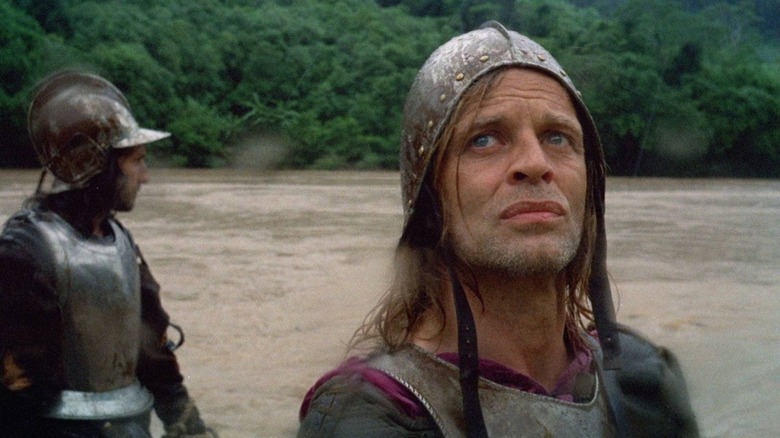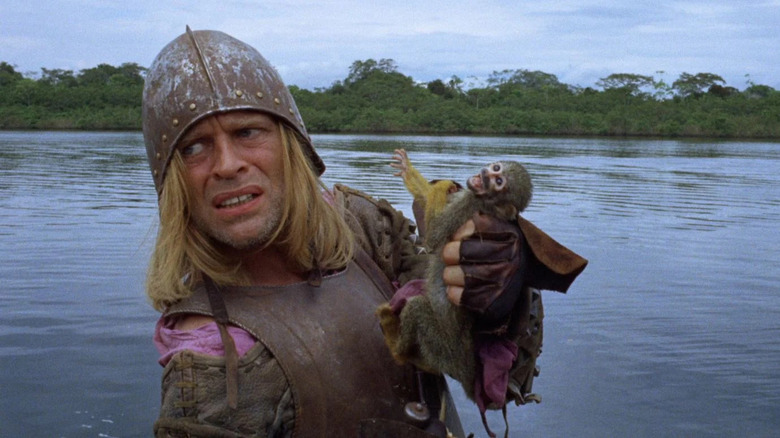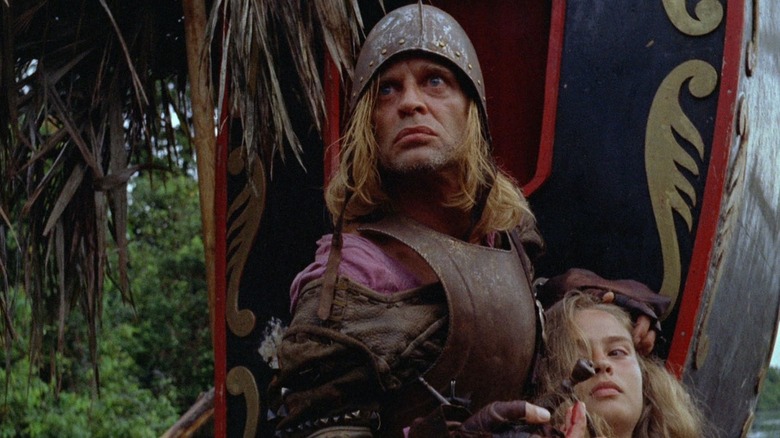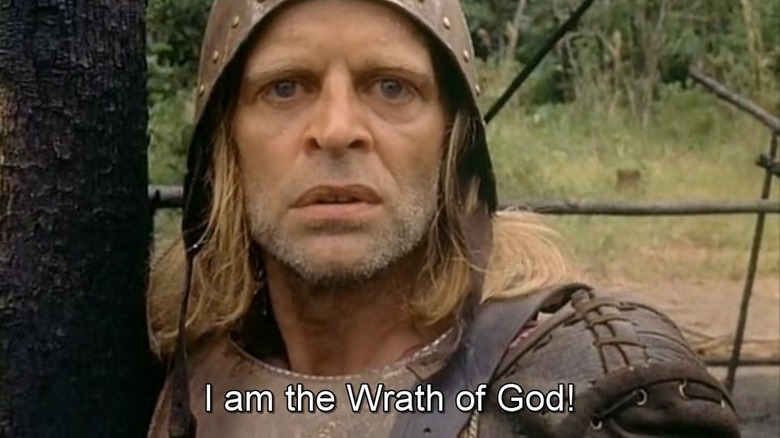Klaus Kinski's Aguirre, The Wrath Of God Casting Was More Than A Little Risky
There sure aren't many (or any, really) stories about actor Klaus Kinski (1926 – 1991) detailing how calm, studious, and judicious he was. Werner Herzog, who made five films with Kinski, once described him as "one of the greatest actors of the century, but also a monster and a great pestilence." He was known for tantrums and violent outbursts, often badgering studio heads for higher and higher salaries. Reading his autobiography, "Kinski Uncut," is a dizzying experience, hacking through page after page of alleged sexual conquests and barely-controlled wrath. In the 1999 documentary "My Best Fiend," Herzog's film about his tempestuous relationship with Kinski, Herzog openly said that Kinski lied in "Kinski Uncut."
Film students likely all know the story of Kinski and Herzog coming to blows while filming the 1983 film "Fitzcarraldo," a harrowing film wherein a crew of nonprofessionals were tasked with literally dragging a full-size ship over a hill. It was physically taxing, the shooting locations were remote, the food supplies were not the most robust. Despite, or perhaps because of all this, Kinski was on his s***. He would regularly scream at Herzog, and Herzog admits to wanting Kinski dead more than once. Herzog even claims that several members of the crew offered to murder Kinski for him. Herzog demurred. A similar story comes from director David Schmoeller, who directed Kinski in his 1986 film "Crawlspace." In a 1999 short film called "Please Kill Mr. Kinski," Schmoeller recalls how difficult Kinski was to work with, and, having been prevented from firing the actor by studio higher-ups, had seriously considered an offer — from "an Italian producer" — to have Kinski assassinated. By the end of the shoot, many crew members were asking Schmoeller if he had reconsidered the offer.
Given his reputation for bad behavior and tendency to throw tantrums, working with Kinski was always going to be a risk to both sanity and shooting schedules. As such, when Herzog first approached Kinski about appearing in his 1972 film "Aguirre, the Wrath of God," he knew that he would be trapped in a jungle with the actor for an extended period, knowing that Kinski could explode at any minute. In 2005, to celebrate the release of his film "Invincible," Herzog had a long conversation with Roger Ebert about those risks.
Porno for money
In "Aguirre, the Wrath of God," Kinski plays the title character, the real-life conquistador Lope de Aguirre, who led a doomed mission down the Amazon to find the lost city of El Dorado. What followed was mounting madness, violence, and death at the hands of a vast, indifferent natural world. Filming "Aguirre" took five weeks, and Herzog shot on location in Peruvian rainforests.
Herzog reminisced with Ebert about his earliest memories of Kinski's antics from when Herzog was only 13.
"[W]hen he was in Italy, [Kinski] earned a lot of money. There was always a trail of devastation behind him, and some of it was not funny because part of him was really, really, really bad. So he may rest in peace, and make his peace with the creator if ever he encounters him. I was 13. One day I asked him to do "Aguirre." When I sent him the screenplay, 12 years later, I knew if he would accept it, what I had to expect, but I was never afraid."
Ebert pointed out to Herzog that most directors don't work with notorious actors.
"When you know that there is only one option that you have, there is no alternative. There is absolutely no alternative. But Kinski doing 'Aguirre' ... [one] must not be afraid of actually doing it, and no matter what comes along you will prevail as long as it's a secure vision."
A secure vision, and, of course, money. Kinski often claimed to be one of the world's greatest of actors, but there were often rumors about how a high salary and a convenient shooting location were more important factors for him when selecting roles.
"He would even do hard-core pornos for money. Money, money, money! And if for any reason he would start to scream, he would scream until he had frost on his mouth. He would scream about this pig who didn't offer him decent money, who was this psychopathic a**hole. Obviously he made some distinctions, because I obviously paid him much less than others would offer him. I mean a fraction of that. I didn't have the budget. Kinski the bastard won a third of the entire budget."
I'll do it for a million dollars
Herzog recalls a particular incident of Kinski's avarice on display: The film was out of money, but Herzog still needed to re-record some of the dialogue. He asked Kinski to come back and read some of his lines to get cleaner audio. Kinski made an unreasonable demand:
"And then, there's an interesting thing, the real good version is the German version, it's the authentic version, but since we filmed a lot in rapids there was such a huge noise that — of course we did have some direct sound — but you could hardly understand a word. We had to post-synch it, so I said to Klaus, 'We need you for looping, for one and a half days.' He said, 'Yes, I'm coming, but it will cost a million dollars.'"
Wait, what? For looping his own dialogue?
"And there was absolutely no way. He knew, of course, I didn't have a thousand dollars. Everything was gone. My wrist watch was gone, everything. And he asked for a million dollars. He hated the film so badly, you could not believe it. And he didn't show up for looping so I looped it with a different voice, and the voice is as good as Kinski. I took a lot of effort; nobody, nobody would ever know. But you know it now. Can you please not ...? Do not leak to the press."
I have a rifle
Herzog also tells a story of how he had to get Kinski back in line during the shoot. Kinski was throwing a tantrum — as usual, according to Herzog — because a still photographer committed the unforgivable transgression of smiling. Kinski was incensed by a smiling photographer, and threatened to walk off the set, which Herzog knew was no idle threat; Kinski had walked off the sets of 35 movies in the least five years. Kinski got in a speedboat, screaming all the while, as Herzog explained firmly that Kinski's career would not survive this. Herzog — who wanted it known that he was not armed at the time — had to make a grave threat just to get Kinski to pay attention:
"I said to him, 'I do have a rifle,' very calmly. He could try to take the boat and he might reach the next bend of the river but he would have eight bullets through his head. But of course there were nine bullets, and I said, 'Guess who gets the last one?' And he looked at me and he understood it was not a joke anymore. I would have done it. He understood he better behave. And it was kind of hostile for the next couple of days. But what I'm trying to say is, the incident may sound funny now, and it seems funny and bizarre to me; if I sat out there I would laugh with you. But what I'm trying to say is that there's always been a very clear borderline, a line that must not be stepped over. So once you accept the duty you have to understand the duty that is upon you. I've always understood it myself.
Herzog and Kinski often brought out the worst in each other, making for painful, tempestuous shoots and astonishing films of unfaked struggle. Herzog often works in extremes, putting himself in danger to get a shot (he once shot a scene on the rim of an erupting volcano), or merely trekking to impossible locations. I recommend the Les Blank documentary "Burden of Dreams" about the making of "Fitzcarraldo," which contains all the struggles that production encountered.
Herzog's last film as director was a documentary about meteors called "Fireball: Visitors from Darker Worlds." Kinski died in 1991 at the age of 65 after a lifetime of struggling with mental illness, followed by posthumous assault accusations from his own family members. Only one of his three children attended his funeral.



